When chronic shoulder pain begins to interfere with your quality of life, it’s easy to feel frustrated or overwhelmed. Still, transcutaneous electrical nerve stimulation (TENS) may help. TENS units are used to treat everything from arthritis to fibromyalgia, and there are thousands of models available.
We concluded that the best TENS unit for shoulder pain is the iReliev Premium TENS + EMS unit.
The TENS Pain Relief System is a budget-friendly alternative that’s sure to impress. Still, shoppers seeking a middle-ground between these may want to consider the TENS + EMS Pain Relief & Recovery System.
In this article, we’ll take an in-depth look at these three iReliev TENS units, delve into the potential benefits of using a TENS unit for shoulder pain, and answer some of the most frequently asked questions on this topic.
Our Favorite
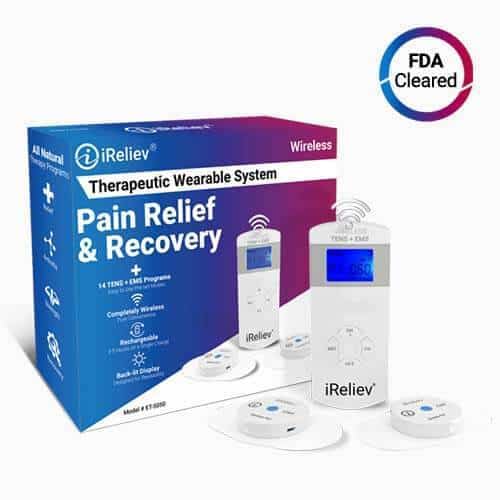 iReliev Premium TENS + EMS Therapeutic Wearable System
iReliev Premium TENS + EMS Therapeutic Wearable System
For serious shoulder pain relief, there’s no better option than the iReliev Premium TENS + EMS System. Not only is it completely wireless, making it one of the best all-day wearable TENS units, but it also features a fast-charge rechargeable internal battery that can last years.
Users only need to attach the multi-sized wireless electrodes and receiving pods to trouble areas and select their chosen program and intensity to enjoy the pain-relieving, relaxing effects of this TENS/EMS unit. And because the pads are reusable, you won’t need to order replacement pads as regularly, saving you money over time.
The electrode-studded pads are applied directly to the skin and are powered by rechargeable receiving pods. These receiving pods need to go directly over the adhesive pads in order to function. Still, this combination of components allows the unit to work wirelessly, and the pods are lightweight and thin enough to be worn under loose, comfortable clothing.
Though users will need to charge a total of three devices to use this model (the wireless remote and the two receiver pods), the necessary charging cable is included. Rather than having to rely on three separate USB charging cables, you can enjoy the convenience and simplicity of a single cable with three charging adapters. These three adapters can be plugged into your PC’s USB port to charge, or they can be integrated into an AC/DC adapter system.
The charging time for the iReliev Premium TENS + EMS System is surprisingly low, and the remote can go from drained to fully-charged in as little as three hours. The receiving pods can charge even more quickly, often being ready after an hour and a half. Additionally, it’s easy to tell when these devices are fully charged.
The receiving pods contain a color-changing alert light that glows bright orange while it’s charging, and bright blue when it’s on. However, when it’s finished charging, this center light will shift to a dull gray. And when it’s in use, it may begin to flash to alert users that the battery life is dwindling.
While the wireless remote doesn’t feature a light indicator to alert users to a low battery, it will flash a ‘low battery’ icon at the top of the display screen to let users know that remote shut-off is imminent. When charging, it will also display a ‘full battery’ icon to let you know that it’s ready for use.
Thanks to a bright, backlit screen, it’s always easy to read displayed data on the wireless remote. In addition to alerting users about a failing or fully-charged battery, the display screen can also show:
- The chosen program number
- The set therapy mode (TENS or EMS)
- The wireless connection status
- The time remaining for the treatment session/set timer amount for the session
- The desired intensity level
- The current channel you’re accessing
Below the display screen are four directional buttons to help users select their desired program, mode, intensity level, channel, and timer amount. Everything is clearly labeled and easy to read, making operation a breeze. Users can select one of 14 programs to help facilitate maximum relief.
The preset programs encompass both TENS and EMS therapies and include:
- TENS therapies for chronic and acute pain
- An arthritis-focused TENS therapy
- Constant, modulated, or ‘burst’ intensities for each program
- Pre-exercise EMS warm-up therapy
- Muscle-recovery therapies
- Muscle-strengthening therapies
Each program uses a specific pulse rate and pulse width, ensuring that users experience the ideal amount of stimulation for their pain level and injury. The included Output Mode guide is a fantastic resource for learning more about what each program can do. Thanks to the quad-channel design, you can use as many four pads and pods per session, and target multiple areas of the body at the same time.
But, if you are planning on taking advantage of the four channels, you’ll need to purchase additional receiving pods, as the system kit only comes with two. Still, the included hard plastic case with snapping closures is a nice touch, and can help you keep all the components together, and in top-notch condition.
In addition to relieving shoulder pain, the iReliev Premium TENS + EMS System is also an excellent option for those with fibromyalgia, as the gel electrode pads contain zero salicylates. Overall, there’s no better, more convenient, or more effective TENS/EMS unit for shoulder pain than this one, which is why it’s our favorite.
Battery Type: Rechargeable
Channels: 4
Wireless: Yes
Included Pads: 10
Programs: 14
EMS: Yes
Budget Pick
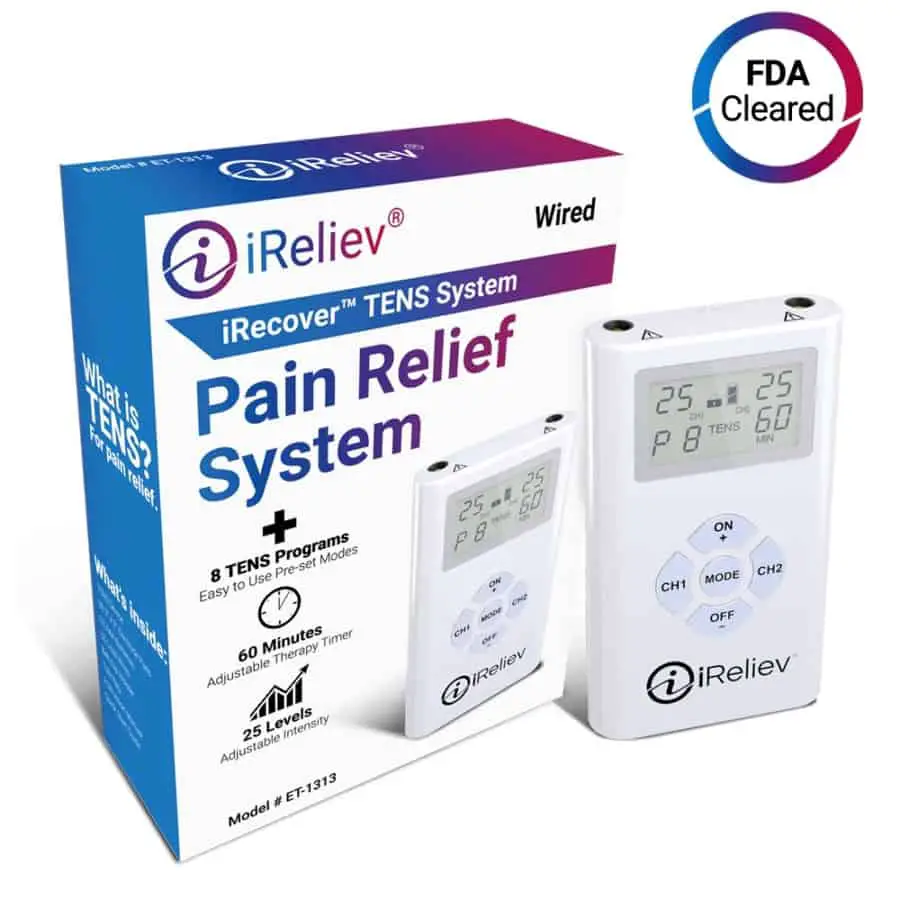 iReliev TENS Unit Pain Relief System
iReliev TENS Unit Pain Relief System
The Premium TENS + EMS System may be out of your budget range, but that doesn’t mean you can’t enjoy the benefits of a high-quality, pain-relieving TENS unit. The budget-friendly iReliev TENS Unit Pain Relief System is a simplified, effective solution to body aches and pains, and while it may not be wireless, it does have quite a few attractive features that make it an excellent option.
Firstly, this unit is charged via three AAA batteries. While this means that you’ll need to purchase replacement batteries throughout the life of this machine, it also means that it will last longer than rechargeable ones over a long term period. So, if you’re serious about benefiting from effective TENS care and therapy for many years to come, this device won’t let you down.
While the Pain Relief System originally only comes with four electrode pads, you could score an extra four pads and a carrying case by ordering at the right time. Fortunately, iReliev often lists its products at discounted, shopper-friendly prices, helping to ensure greater accessibility to their wide range of medical devices.
However, even without the bonus equipment and materials, this system is a fantastic example of an effective, convenient, handheld TENS unit. The lightweight control device has two channels, allowing for up to four small electrode pads to function at the same time. This means that users can place electrodes at all vital locations around a sore area: above, below, and parallel.
Still, the small pads are reusable and come with a skin-friendly adhesive. The lead lines connecting the pads to the control unit are reasonably long, allowing users to place the pads around the upper shoulder while still keeping the unit in their palm or pants pocket.
In addition to the long lead length, this unit can operate for months without needing a new set of batteries. Also, the control unit features a locking mechanism that ensures that accidental button-pressing never becomes a dangerous issue.
Wondering how high you can set a TENS unit? Click here to read more…
The included belt clip is an excellent way to keep the unit handy and out-of-hand. And the tote bag that also comes with this unit helps to keep the device safe and close-by. Consequently, you can easily use this unit while on-the-go.
The control device features a rectangular display screen. While this screen does not light up, which could become an issue for some nighttime users, it does display a condensed and easy-to-read set of data. Users can access the following via the display screen:
- The set program number
- The set intensity levels for both channels
- The battery charge level and status
- The set timer amount
- The lock status of the device
This unit has a reduced number of available programs, but each one is designed more maximum pain relief. This device can provide therapy to users who experience both chronic and acute pain, in addition to individuals who suffer from arthritis pain and discomfort.
Each program features a specific pulse rate and output mode that best befits the type of pain experienced by the user. This means that users can experience a pulse rate between 2Hz and 245Hz. And the output mode varies among constant, modulated, burst, and cyclical.
The iReliev TENS Pain Relief System’s greatest drawback is its lack of EMS therapy options. Individuals with shoulder pain may be athletes or active individuals who are seeking to strengthen their shoulder muscles while reducing pain associated with that area. Sadly, this device isn’t built to handle these types of users.
Still, this model can be safely placed on 11 different regions of the body and emits strong, therapeutic electrical signals. Its automatic shut-off feature helps extend overall battery life and is a smart design decision. To help users avoid accidental injury or unit misuse, the intensity level resets after every use.
When you consider all of these factors, it becomes obvious that this is one of the best and most affordable TENS units currently available. It’s objective is singular: Provide intense, localized pain relief. However, just because it doesn’t provide both TENS and EMS therapies doesn’t mean it isn’t an excellent option for those seeking drug-free pain relief.
Still, those looking for an affordable TENS/EMS machine can choose to upgrade to the iReliev TENS + EMS Pain Relief & Recovery System.
Battery Type: Replaceable
Channels: 2
Wireless: No
Included Pads: 8
Modes: 8
EMS: No
Get an Upgrade
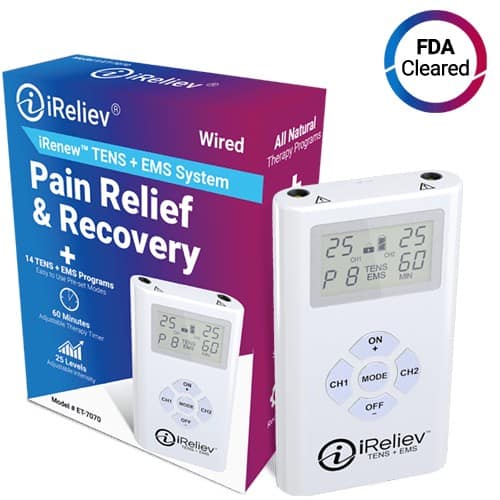 iReliev TENS + EMS Pain Relief & Recovery System
iReliev TENS + EMS Pain Relief & Recovery System
If you’re looking for a TENS/EMS unit that falls somewhere between the more expensive iReliev Premium TENS + EMS System and the wallet-friendly iReliev TENS Unit Pain Relief unit, then the iReliev TENS + EMS Pain Relief & Recovery System may be the ideal option for you.
It’s essentially the Pain Relief unit, but with a greater variety of electrode pads and modes. This means that it shares many of the positive qualities of the Pain Relief unit, but not all of its negative qualities. Perhaps the most noticeable difference between these two units is their functionality.
The Pain Relief & Recovery System is capable of providing both TENS therapies and EMS therapies. Like the Wearable System, this one has 14 programs that are designed for specific pain-relieving, muscle-strengthening, and relaxing therapies. Here’s a brief overview of what these programs entail:
- Program One Through Program Eight. These programs consist of TENS therapies and treatments. Their primary purpose is to relieve acute and chronic pain. These programs can be utilized to lessen symptoms of pain all over the body, except for the head and neck region. Program Eight is specifically designed to help treat pain associated with arthritis.
- Program Nine Through Program Fourteen. These programs are EMS therapies that focus on muscle-building, toning, healing, and strengthening. They’re an excellent option for athletes, laborers, and active individuals who occasionally experience muscle soreness. They can also help those with muscle atrophy regain strength and muscle tone.
Before starting a program, you’ll need to select your desired intensity and timer settings. Each session can last anywhere between five minutes and a full hour, and users should generally start with a low-intensity 15-minute session before increasing any settings. This ensures that users never harm themselves while attempting to enjoy their TENS therapy.
How to setup a TENS unit? Click here to learn more
Like the Pain Relief System, the upgraded Pain Relief & Recovery System has a locking mechanism and belt loop adapter to increase over portability. This device is easy to use while running errands, working at a desk, or simply relaxing on the couch. And thanks to the timer options, you’ll never need to worry about experiencing too much stimulation.
Accessing the program menu and additional settings is incredibly simple, and the five directional buttons are each labeled for ease-of-use. Another positive quality of this system is the included large-sized electrode pads. These expansive pads are perfect for shoulders, the upper back area, and the lower back area.
And because this control unit features two channels, a maximum of two large pads can be used concurrently. This means that users can experience total shoulder pain relief throughout each session, and can even treat both sides of the body at the same time. Those looking to enjoy a wide variety of EMS therapies are bound to enjoy what this unit has to offer.
The following are included in EMS programs:
- Exercise Prep. It’s important to warm-up before exercising. Doing so allows muscles to “breathe” before stretching, straining, and rebuilding themselves. The very first EMS program on this device is a warm-up mode designed to get muscles ready for exercise.
This program provides a rhythmic pulse that simulates the feeling of a muscle-relaxing massage.
- Muscle Recovery. The muscle recovery mode simulates tapping massages and generates a low-intensity muscle twitch that can facilitate faster muscle healing and recovery. This program can also help to reduce muscle stiffness and fatigue.
- Endurance Building. The endurance-building program can help users increase circulation in specific regions. This results in increased blood flow during and after treatment, potentially increasing the body’s aerobic capacity and ability.
- Active Recovery. This unit has two different active recovery programs for users to enjoy. The first one is very similar to the muscle recovery mode, but it is slightly softer and more gentle. The second active recovery program produces a kneading sensation and is the more intense of the two.
So, if our favorite model is more than you’re looking for over budget, you may want to take a second look at this upgrade option.
Battery Type: Replaceable
Channels: 2
Wireless: No
Included Pads: 12
Programs: 14
EMS: Yes
Want to know where a TENS unit can be placed? Check out my TENS placement guide here. Below are a few common TENS electrode pad placements:
Benefits of Using a Tens Unit for Shoulder Pain
Using a TENS unit for shoulder pain has several potential benefits. Studies regarding the effects of TENS units and EMS devices are still ongoing. Still, there is enough data to support the idea the electrical stimulation can be used to:
- Lessen postoperative pain
- Lessen chronic pain related to arthritis
- Lessen chronic pain related to nerve conditions
- Treat mood disorders, including depression
- Lessen chronic pain in the upper and lower back
- Lessen chronic pain in the shoulders
This is only a shortened list of a TENS unit’s total benefits. As the medical community continues to investigate the potential healing and therapeutic effects of TENS units, it’s likely that the number of uses for these handheld devices will grow.
Benefits of Using a Combined EMS Device
While TENS units are designed to help alleviate pain by changing the body’s perception of it, combined TENS/EMS devices do a little more. In addition to producing pain-relieving TENS therapies, they can also perform muscle-toning EMS functions. Combined models are popular among athletes, fitness enthusiasts, and laborers.
Not only can they help facilitate the healing process by removing some of the pain associated with it, but they can also shorten the entire ordeal by increasing circulation and promoting faster healing.
Frequently Asked Questions
Below you will find the answers to some of the most frequently asked questions regarding TENS units and shoulder pain. If your question is not listed, don’t hesitate to reach out to your physician or a medical professional for assistance. It’s essential to stay informed and to avoid potential safety hazards, so asking questions is a crucial part of the learning process.
Where Do You Put a TENS Unit’s Electrodes for Shoulder Pain?
The placement of the electrode pads depends on the nature of your shoulder pain. For example, if you’re suffering from a rotator cuff injury, you’ll want to place four total pads:
- One on the front side of your shoulder, close to the edge of your arms and far from your neck or chest.
- One on the backside of your shoulder, aligned with the previous placement.
- One on the top side of your shoulder, aligned with the previous two placements. Be sure that your pads are not overlapping or touching.
- One on your arm, aligned with the previous four placements. The resulting placement pattern should slightly resemble a plus sign or cross.
Of course, if you’re dealing with shoulder pain that is the result of sports injuries, exercise soreness, or bursitis, you’ll want to follow the standard placement recommendation, which is: Always place the pads above, below, or parallel to the source of pain. The more pads you apply, the more intense the treatment will be.
How Often Can You Use a TENS Unit for Shoulder Pain?
You can safely use a TENS unit for several hours a day, and the standard maximum amount of time is about three hours. It’s a great idea to begin your TENS experience by sampling a 15-minute session. If you still experience pain after this initial trial, you can adjust the timer settings and intensity level and try again.
However, using your TENS machine more than three times a day can result in regional soreness and excessive muscle twitching. Still, how you use your TENS unit (and how often) typically depends on your level of pain.
Who Should Not Use a TENS Unit?
There are a few individuals who should not use TENS units and still others that may want to consult with their doctor before using one. If you identify within one of the following groups, please use caution and follow official medical guidelines and recommendations.
You should not use a TENS unit if you:
- Are pregnant
- Have a pacemaker
- Have a heart condition
- Have any kind of internal electronic device
The electrical impulses produced by a TENS unit can wreak havoc on internal electronic devices, like pacemakers. They can also negatively interact with the electrical impulses that control the heart. And, while a TENS unit can be used by pregnant women who are in labor, they should not be used during the majority of the pregnancy.
Also, individuals with epilepsy will want to ensure that they never place a TENS unit pad close to their head or neck, as this could cause seizures.
Where Should You Not Use a TENS Unit?
Most of the body is open to electrode placement, but there are a few areas that are strictly off-limits. If you intend to use a TENS unit for shoulder pain relief, you should never place the pads on your:
- Head
- Eyes
- Neck
- Ears
- Chest
- Genitals
While some devices may feature a “head mode” or “ear program,” it’s important to ignore those recommendations. Placing a specialized electrode on your ear’s tragus can be beneficial if you suffer from epilepsy or depression, but standard TENS pads are not built for this type of therapy.
Applying a TENS pad to your neck or head is dangerous. That’s because electrodes emit strong electrical signals, and placing them too close to the brain can result in signal confusion. Because our brains rely on these signals to regulate heartbeat, breathing, and other vital processes, confusing them with a TENS device could result in a potentially fatal injury.
Is a TENS Unit Good for Shoulder Bursitis?
Yes, a TENS unit can be an excellent therapy option for individuals with shoulder bursitis. While it may cure the condition, it can help alleviate pain associated with bursitis.
What Is the Difference Between TENS and EMS Devices?
Because individuals with shoulder pain may benefit from a combined TENS/EMS device, it’s important to understand what these terms mean and how these devices differ. This can be a tricky topic to tackle because a TENS unit and an EMS device essentially do the same thing.
Both devices emit electrical pulses or signals via a central control unit and several linked electrode pads. However, the main difference between these two machines comes down to usage. A TENS unit is specifically designed to help users change their perception of pain and experience temporary pain relief.
An EMS unit, on the other hand, is designed to cause muscle tissue and skin to contact, resulting in stronger, healthier, more toned muscles. EMS functions tend to focus on ‘pulling’ on the muscles and increasing localized circulation, while TENS therapies are meant to block or override pain signals.
Conclusion
While we feel like the NueMedics model is the best TENS unit for shoulder pain, we can’t deny that the Etekcity model is an exceptional budget-friendly alternative. Still, the NueMedics unit is portable, durable, long-lasting, easy to use, and just right for providing localized relief from shoulder pain.
Still, if you’re interested in upgrading to a slightly more attractive option, you can always choose to invest in the TechCare Touchscreen TENS unit. Its hyper-efficient design, accessible touchscreen, and included materials make in an outstanding option. Of course, the potential benefits you may experience from using one of these devices depends on several factors, such as pad placement, therapy intensity, and pre-existing pain level.
However, using the information contained within this article, you’ll have the best chance of finding success while using a TENS unit for shoulder pain.
Sources
- iReliev: Pre-set Output Modes
- iReliev: The Difference Between TENS vs EMS
- iReliev: Premium TENS + EMS Therapeutic Wearable System
- iReliev: TENS Unit Pain Relief System
- iReliev: TENS + EMS Pain Relief & Recovery System
- MedicalNewsToday: When to Avoid TENS
- Patient: TENS Machines
- SelfHacked: 11 Interesting Uses of TENS Units for Pain Relief & More
- Wikipedia: Transcutaneous electrical nerve stimulation

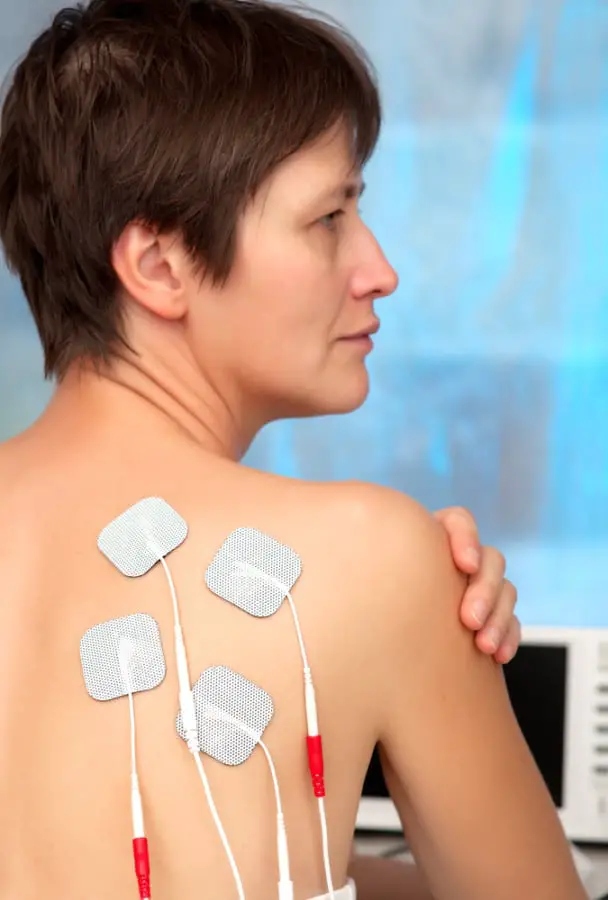
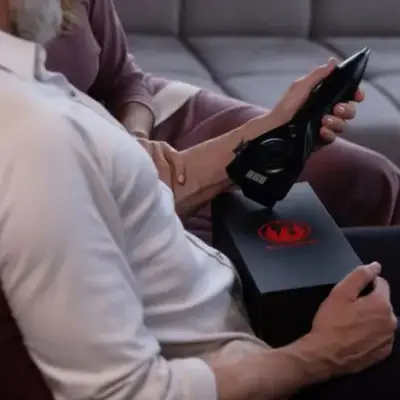

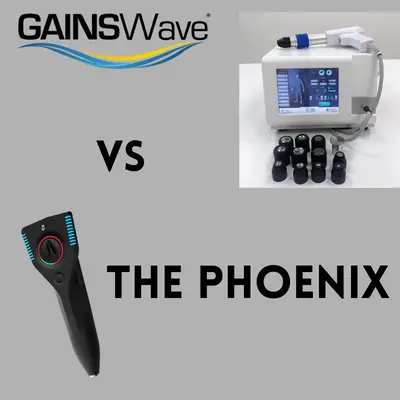
2 responses to “Best TENS Unit for Shoulder Pain (2023)”
[…] A TENS unit can be used to relieve pain associated with a long list of painful medical conditions. Back pain caused by degeneration of the spine, problems with discs in the back, or after back surgery. These are the common conditions that a TENS unit can help reduce/relieve pain. […]
[…] contain zero salicylates. Overall, there’s no better, more convenient, or more effective TENS/EMS unit for shoulder pain than this one, which is why it’s our […]